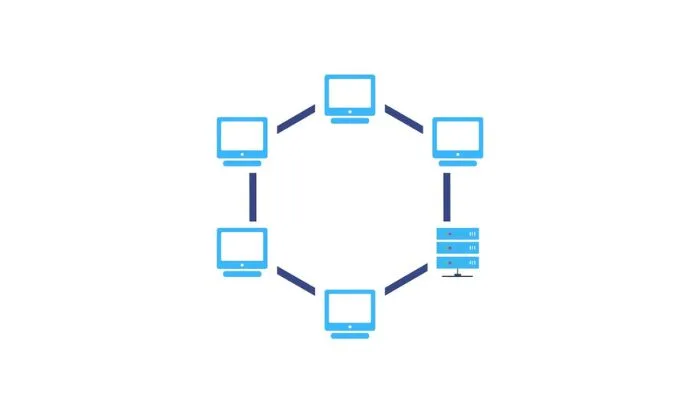Table of Contents
What is Ring Topology?
A ring topology is a network setup in which the connections between nodes form a closed loop. Like the nodes of a circle, each connected device is in communication with two others. A network of rings is a collection of devices connected in a circle.
Data packets in a ring network hop from node to node until they reach their final destination. Most ring topologies are unidirectional, meaning that packets can only move in one direction. Others are bidirectional, meaning they allow data to travel both ways.
The most significant drawback of a ring topology is the widespread impact of a single connection failure.
Both local area networks and large area networks can benefit from a ring topology. In a ring topology, computers are linked together via either coaxial cable or RJ-45 network cable, depending on the type of network card installed in each machine.

How Does Ring Topology Work?
In a ring topology, each device is interconnected with two other devices in a circular formation. This type of network arrangement facilitates the transmission of data from one device to another until it reaches its intended destination. The data is transmitted within this topology through the use of tokens, hence its name – token ring topology.
Ring topology is sometimes referred to as active topology because it requires all nodes within the network to remain active for data transmission. However, in larger networks, tokens may need to traverse multiple nodes before reaching their destination, potentially resulting in data loss. To mitigate this issue, repeaters are installed to strengthen the signal.
In a ring topology, data transmission between different nodes follows these steps:
- Empty tokens circulate freely within the ring, with speeds ranging from 16Mbps to up to 100Mbps.
- These tokens serve as placeholders for storing data frames and contain the sender’s and receiver’s MAC addresses1.
- When a transmitting node intends to send a message, it seizes a token and fills it with data, the MAC address of the receiving node, and its own ID in the designated spaces of the token.
- This filled token is then passed to the next node in the ring. The receiving node checks whether the data has been copied from the frame to the node. If so, the token is reset to zero and forwarded to the next node; otherwise, it is simply passed along.
- This process continues until the data reaches its intended destination.
- Once the token returns to the sender and confirms that the data has been read by the receiver, it separates the message.
- The token is then ready to be reused and can be picked up by any node in the network.
In the event that a node remains stationary within the ring network, causing a communication breakdown, and the network supports a dual ring, data is transmitted in the reverse direction towards the destination.
Ring Topology Components
To understand how Ring Topology works, let’s explore its essential components:
1. Nodes
Nodes, also known as devices, are the endpoints in a ring network. These can be computers, servers, switches, hub, or any other device capable of connecting to the network.
2. Connections
Connections, often in the form of cables or fiber optics, link nodes together in a circular fashion. Data travels through these connections from one node to the next.
3. Data
Data packets containing information to be transmitted move through the ring. These packets circulate until they reach their intended destination.
The Mechanism of Ring Topology
Ring Topology operates using a specific mechanism that ensures orderly data transmission:
- Data Transmission: When a node sends data, it travels through the ring in one direction, passing through each node along the way.
- Token Passing: To prevent data collisions, Ring Topology uses a token-passing mechanism. A token circulates the ring, and only the device holding the token can transmit data. Once data transmission is complete, the token moves to the next node.
- Data Reception: Each node examines incoming data packets. If the data is not intended for that node, it simply passes it along the ring.
- Destination Node: The data packet circulates until it reaches its destination node. Once received, the node processes the data, and if necessary, generates a response that also circulates the ring.
Applications of Ring Topology
- Local Area Networks (LANs): Ring topology is commonly used in small to medium-sized LANs, such as those found in offices, schools, or small businesses. Its predictable data path and relatively simple setup make it a suitable choice for these environments.
- Fiber-Optic Networks: Fiber-optic communication networks often employ ring topology due to the high data transmission speeds and reliability offered by optical fibers. This is especially prevalent in telecommunications and internet service provider (ISP) networks.
- Security Systems: Ring topology is favored in security systems, including surveillance camera networks and access control systems. Its fault tolerance ensures that critical security information is consistently transmitted.
- Industrial Automation: Manufacturing plants and industrial facilities use ring topology to create robust and dependable networks for process control, monitoring, and data acquisition. The high reliability of ring topology is essential in these environments.
- Public Transportation Systems: Ring topology is sometimes utilized in public transportation systems, such as trains and buses, to establish communication networks for monitoring and managing vehicle operations, safety, and passenger information systems.
- Stock Exchanges and Financial Institutions: In the world of finance, where split-second transactions are critical, ring topology networks are employed for their data integrity and reliability. Stock exchanges and financial institutions rely on these networks for secure and efficient trading.
- Broadcasting and Television: Television studios and broadcasting companies often use ring topology for their internal communication networks. This ensures that audio, video, and data signals are consistently transmitted without interruption.
- Aircraft Communication Systems: In aviation, ring topology is employed in aircraft communication networks to ensure continuous and reliable communication between various onboard systems, including navigation, weather monitoring, and in-flight entertainment.
- Healthcare Facilities: Hospitals and healthcare facilities use ring topology for their data networks, especially for connecting medical devices, electronic health records, and diagnostic equipment. The reliability of ring topology is vital in these settings.
- Military and Defense: Military installations and defense systems rely on ring topology networks for their robustness and ability to maintain communication in adverse conditions. They are often used for command and control purposes.
Advantages of Ring Topology
- Easy Implementation: Setting up a ring topology network is straightforward and allows for the addition of new devices without much disruption.
- High Performance: Ring networks boast high data transmission speeds, unaffected by heavy load.
- Scalability: Adding workstations to a ring topology network is a simple process that doesn’t degrade performance.
- Dependability: Ring topologies offer redundancy, ensuring network reliability even in case of node failures.
- Less Data Collision: One-way data flow in ring topology reduces data collisions, simplifying data delivery.
- No Need for a Server: Ring topology networks don’t require a central server, granting each workstation its connectivity.
Disadvantages of Ring Topology
- High Cost: Setting up a ring topology network can be expensive due to hardware requirements.
- Slow Speed: Data transmission in ring topology can be slower compared to other topologies, leading to potential delays.
- Security Issues: As data passes through all connected workstations, there are security concerns regarding unauthorized access to sensitive information.
- Resilience: Ring topology networks are vulnerable to failure if one node experiences issues.
- Equipment Connection: Adding or removing nodes can disrupt network activity in a ring topology.
- Cable Deficiency: The entire network relies on a single cable, making it susceptible to failure if the cable is damaged.
- Bandwidth Constrictions: As more devices are connected, bandwidth can become limited, leading to communication hiccups.
Is it Expensive to Use Ring Topology?
Indeed, the cost of ring topology systems is often higher due to the cost of the hardware and cables necessary for the network setup. Alternative topology choices, such as star topology, may prove to be more cost-effective in circumstances where funds are at a premium.
Importance of Ring Topology in LAN
Local Area Networks (LANs) are essential for connecting devices within a specific geographic area, such as an office building. Ring topology offers several advantages in LAN environments:
- Reduced Packet Collisions: Data flows in one direction in a ring topology, reducing the likelihood of packet collisions.
- No Need for a Network Server: Ring topology doesn’t rely on a network server for control, simplifying network management.
- High-Speed Data Exchange: Workstations in a ring topology can exchange data at high speeds, ensuring efficient communication.
- Scalability: Adding more workstations to a ring topology network doesn’t impact performance.
Difference Between Ring Topology and Star Topology
Ring topology and star topology are two common network designs, but they differ in several ways:
- Definition: Ring topology forms a closed loop where all devices are interconnected, while star topology connects all devices to a central hub or router.
- Number of Nodes: The number of connections in ring topology matches the number of nodes, whereas in star topology, the number of connections can vary.
- Complexity: Star topology is generally simpler to set up than ring topology due to its straightforward structure.
- Cost-Efficiency: Star topology is often more cost-effective than ring topology.
- Data Transmission: In star topology, data is sent from a central hub to all nodes, while in ring topology, data moves between adjacent nodes.
- Usage: Star topology is commonly used in LANs and is highly extensible, while ring topology may be used in WANs but is less expandable.
Learn More What is Star Network Topology?
Understanding ring topology is crucial for network administrators and engineers, as it offers a versatile networking solution with its unique advantages and challenges. Whether used in LANs or WANs, ring topology continues to play a significant role in modern networking environments.
In conclusion, ring topology is a network design where devices are connected circularly, facilitating efficient data transmission. It offers advantages like easy implementation and high performance but comes with disadvantages like cost and potential security issues. Understanding its importance in LANs and its differences from star topology helps in making informed network design decisions.


